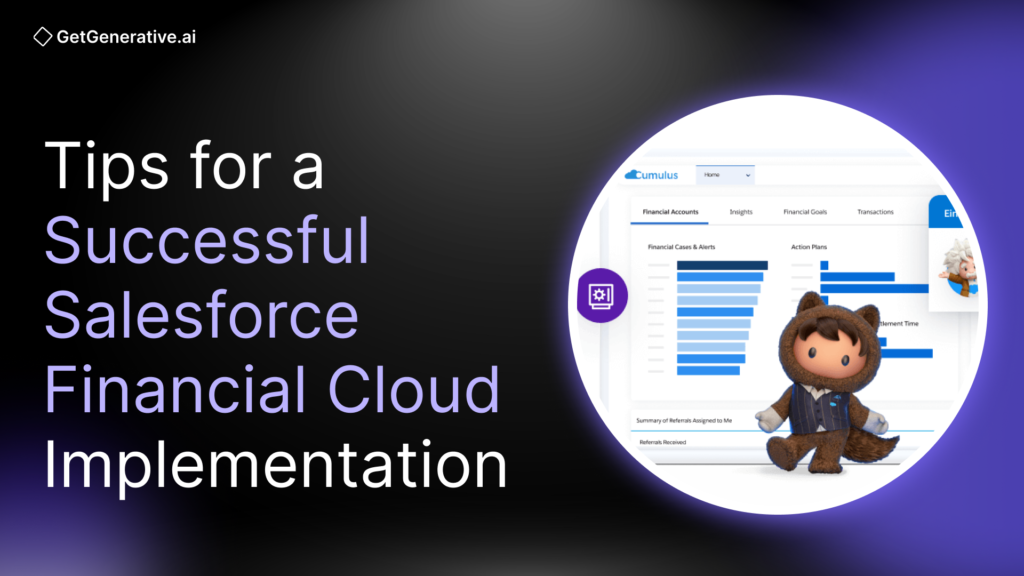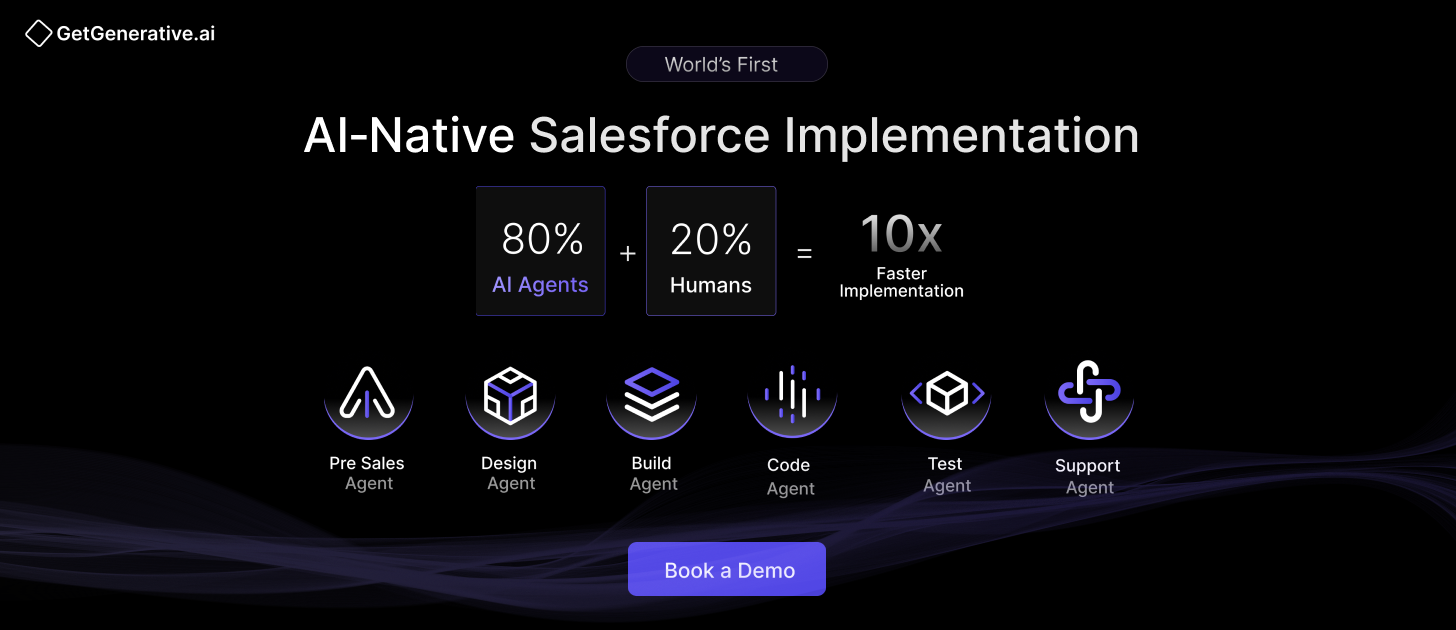Tips for a Successful Salesforce Financial Cloud Implementation
Implementing Salesforce Financial Cloud successfully requires strategic planning, careful execution, and continuous optimization.
This guide offers actionable tips to ensure a seamless and impactful Salesforce Financial Cloud implementation.
Strategic Planning and Stakeholder Alignment
1. Set Business-Centric Objectives
Before touching a single configuration, define strategic goals:
Improve Net Promoter Score (NPS)
Shorten onboarding cycle time
Increase cross-sell ratios
Enhance audit readiness
Stakeholders from sales, service, compliance, and IT must co-create this vision. Conduct requirement workshops, map current-state processes, and identify target-state workflows. According to Synebo, a well-aligned plan significantly improves delivery timelines and post-launch satisfaction.
2. Know Your Segment
Retail banks focus on deposits, lending, and omnichannel services. Wealth managers prioritize risk profiling, portfolio tracking, and relationship depth. Customize accordingly:
Enable different layouts for Advisors vs. Service Reps
Build dashboards around KPIs like AUM or portfolio churn
Tailor Action Plans to workflows like loan onboarding or investment reviews
Also Read – Key Features of Salesforce Financial Services Cloud
Data Strategy: Quality, Governance, and Migration
Poor data quality is one of the top reasons CRM projects fail. Treat data as infrastructure, not an afterthought.
Step 1: Audit and Cleanse
Identify all upstream systems: core banking, DMS, legacy CRMs, spreadsheets
Prioritize de-duplication, standardization, and enrichment pre-migration
Validate key fields: names, account numbers, balances, KYC statuses
Step 2: Govern Early
Appoint data stewards for domains (e.g., Client Profiles, Product Accounts)
Enforce validation rules, picklists, and required fields
Define security policies: use field-level encryption, Shield Platform Encryption for SSNs or income data
Step 3: Integrate Seamlessly
Most FSC implementations require integrating with 5+ external systems (core, LOS, portfolio tools, etc.). Use:
MuleSoft Anypoint Platform for API orchestration
Salesforce Platform Events for real-time sync (e.g., new account opened)
Batch jobs for historical records
Technical Configuration: Build Around FSC’s Industry Model
1. Install and Set Up FSC
Use a Full or Partial Sandbox for testing, Developer Sandbox for configuration
Install FSC Managed Package from AppExchange
Enable critical features:
Person Accounts,Financial Goals,Action Plans, etc.
2. Configure Key Objects
Households: Roll-up family relationships and financial positionsFinancial Accounts: Connect to deposits, loans, insurance policiesFinancial Goals: Track life milestones (retirement, college savings)Client Profile: Store risk scores, investment preferences, and liabilities
3. Automate with Action Plans & Flow
Use declarative tools:
Action Plans for onboarding (e.g., ID check → KYC review → document upload)
Service Console + Flow Orchestrator to manage guided loan applications or claims
Avoid over-customization. Start with the configuration. Use Apex/Lightning Web Components only for unique edge cases.
Also Read – Salesforce CRM Implementation With AI – The Ultimate Guide
Integration with AI, Self-Service, and Analytics
1. Unlock AI-Powered Recommendations
Einstein Next Best Action: Recommend insurance upsells based on household profiles
Predictive Scoring: Flag at-risk clients for proactive outreach
Einstein Bots: Automate support via live chat or SMS
2. Launch Self-Service Portals
Use Experience Cloud for customer portals where users can view balances, update KYC, or raise service requests
Link chatbots for faster servicing—especially important as 48% of banking clients now prefer digital-first engagement (Gartner)
3. Leverage Tableau/CRM Analytics
Visualize KPIs like AUM per advisor, churn risk, and SLA breaches
Integrate with Data Cloud to analyze high-volume transactions and behavioral signals
Testing and Quality Assurance: Getting It Right Before Go-Live
A flawless go-live starts with rigorous testing. The cost of discovering errors post-implementation—especially in financial environments—is steep. Every automation, integration, and custom flow must be validated across real-world scenarios.
Phases of FSC Testing:
1. Unit Testing
Test individual Flows, Action Plans, and automation rules
Validate custom fields and formula logic
Automate Apex tests to ensure future deployments don’t break existing functionality
2. User Acceptance Testing (UAT)
Bring in advisors, compliance users, and service reps to:
Open new households
Simulate onboarding flows
File a mock claim or generate a financial plan
3. Performance & Load Testing
Run bulk data operations (e.g. loading 10,000 accounts) in Full Sandbox
Test report/dashboard rendering for large datasets
Simulate end-of-month batch processing or mass email campaigns
4. Integration Testing
Ensure bidirectional sync with core platforms, LOS, or data lakes
Validate that errors are logged, retried, or escalated appropriately
Key QA Metrics:
Test coverage % (target > 85%)
Defects per test case
UAT completion rates
Data migration error rates
Also Read – Salesforce Financial Cloud Implementation Guide 2025
Change Management and User Training: Driving Adoption
Your CRM is only as good as its adoption. Even a perfectly configured FSC platform will fail without strong change management.
Build a Human-Centered Adoption Strategy
1. Role-Based Training
Develop targeted curricula:
Advisors: Household management, Financial Goals, Relationship Center
Service reps: Case consoles, Action Plans, escalation flows
Compliance teams: Consent tracking, audit logs, policy workflows
Use:
Hands-on workshops
Quick reference cards
Embedded guidance via In-App Help
2. Identify Champions
Train early adopters across departments who:
Participate in UAT
Provide peer training
Report bugs or inefficiencies
3. Rollout in Phases
Pilot in one department (e.g. wealth advisory) before scaling to other business units. Iterate based on user feedback.
4. Monitor Adoption Post-Go-Live
Track logins, key feature usage (e.g., Financial Plan creation)
Use surveys to gauge confidence
Offer office hours or a Slack channel for real-time support
Compliance, Risk, and Security
FSC offers powerful tools, but compliance is never automatic. You must embed governance into both the platform and your business processes.
Compliance Configurations Checklist:
Field History Tracking: Enable for sensitive fields (balance changes, financial goals)
Shield Encryption: Encrypt personally identifiable information (PII) like SSNs or account details
Consent Management: Use Disclosure and Consent objects to log opt-ins and KYC status
Validation Rules: Ensure no record can be saved without AML flags, risk scores, or advisor approvals
Audit Trails: Monitor user activity, setup changes, and field modifications
Regularly review:
Permission Sets: Apply least-privilege principles
Data Access Logs: Ensure no sensitive data is viewed or exported inappropriately
Compliance Dashboards: Track overdue tasks, at-risk accounts, or missing disclosures
Measuring Success: Define ROI from the Start
Without clear KPIs, it’s impossible to justify ROI or drive accountability. Set up pre-launch benchmarks, then track progress post-implementation.
Common FSC Success Metrics:
| KPI | Description |
| Client 360° Completion Rate | % of accounts with complete household and financial profile |
| Advisor Productivity | Accounts managed per advisor |
| Onboarding Cycle Time | Time from lead to account activation |
| AUM Growth | Asset increase post-implementation |
| Compliance Completion | % of tasks completed on time (KYC, risk reviews) |
| Cross-Sell/Upsell Rate | New products/services per client |
Post-Go-Live Governance & Continuous Innovation
FSC isn’t a “launch it and leave it” product. Staying ahead requires proactive iteration.
1. Form a Salesforce Governance Council
Meet quarterly
Review user feedback, new requirements, and regulatory changes
Prioritize roadmap updates
2. Stay Ahead with Salesforce Releases
Review each Salesforce seasonal release (Spring, Summer, Winter)
Look for FSC-specific enhancements, like new objects, UI updates, or Einstein features
Use sandboxes to test before applying to production
3. Run Innovation Sprints
Pilot quick enhancements (chatbots, new analytics dashboards, SMS alerts)
Involve business teams to prototype and test small ideas fast
4. Integrate Emerging Technologies
Add Financial Data Cloud for behavioral segmentation and predictive scoring
Use Einstein GPT or Agentforce to assist advisors in real time
Connect external data (e.g., credit scores, real estate) via MuleSoft/Data Cloud
Conclusion
Implementing Salesforce Financial Cloud is a transformative step for financial institutions, but its success hinges on proper planning, execution, and post-launch support. Adopting these strategies helps you capitalize on Salesforce Financial Cloud’s capabilities, optimize processes, and deliver superior customer experiences.
At GetGenerative.ai, we’ve reimagined Salesforce implementation—built from the ground up with AI at the core. This isn’t legacy delivery with AI added on. It’s a faster, smarter, AI-native approach powered by our proprietary platform.
👉 Explore our Salesforce AI consulting services!




